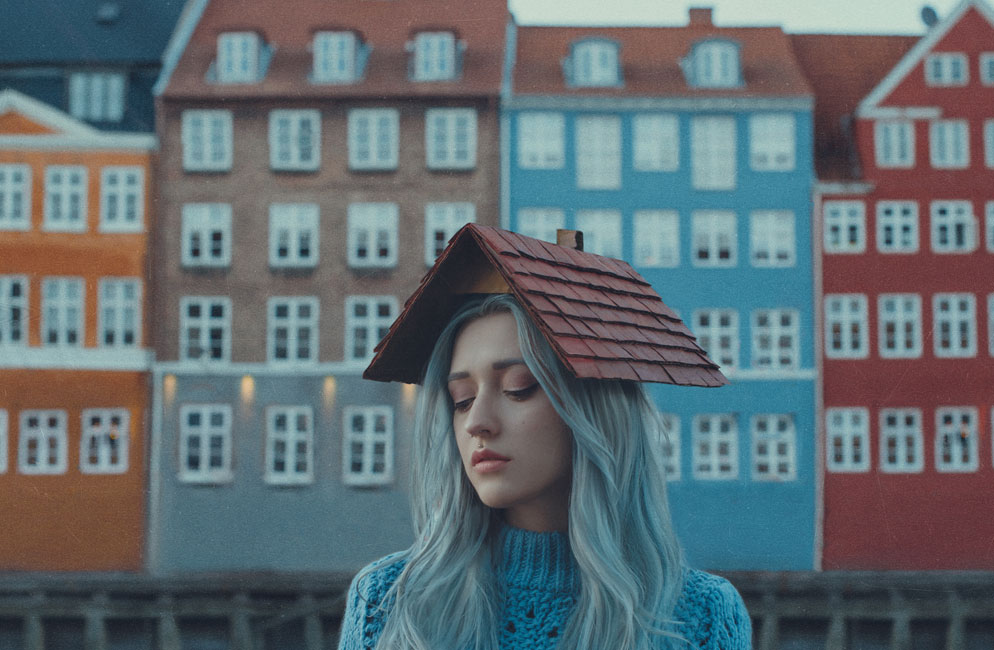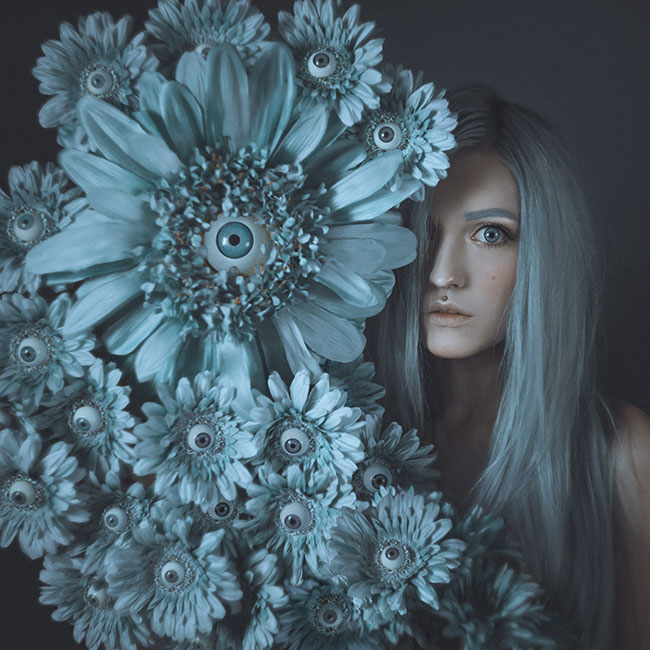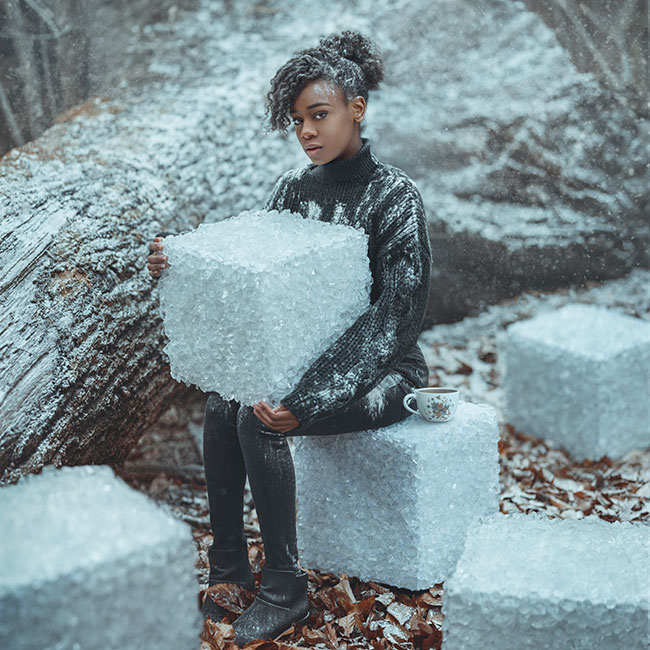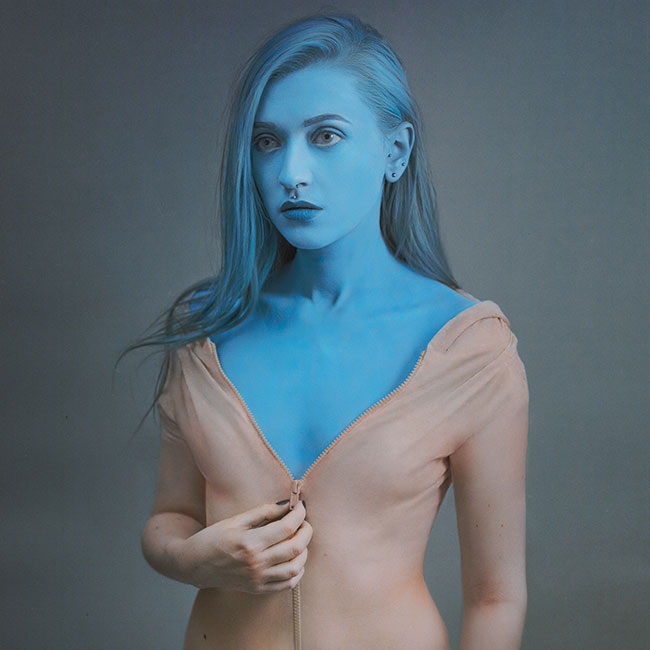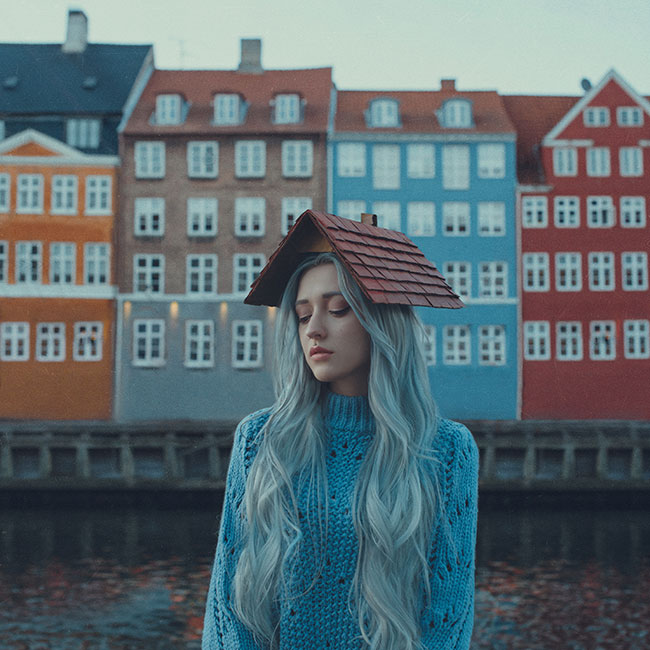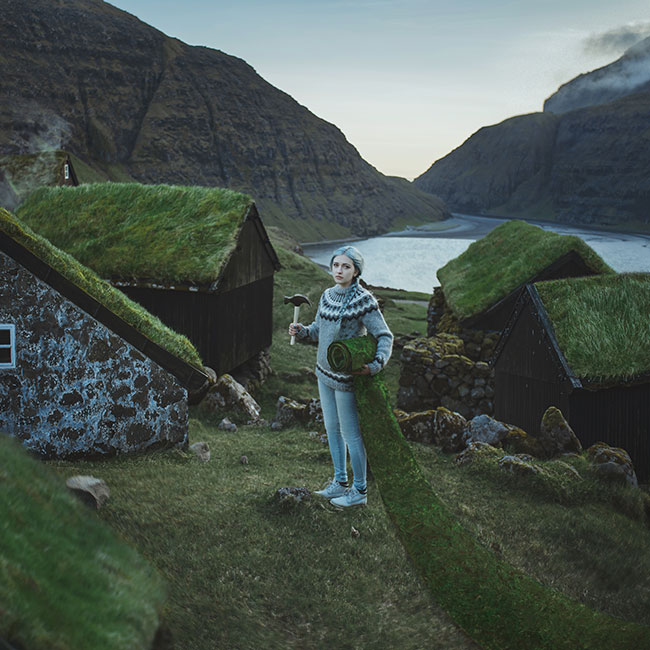The Digital Magic of Anya Anti's Unexpected Images
Anya with a construction of fake flowers and plastic eyeballs. "They were not all blue, so I multiplied them and changed the color. This is one of my favorite self-portraits. It's pretty much what I am inside...a little bit dark, a little bit crazy, but beautiful, I think...I hope." D600, AF-S NIKKOR 50mm f/1.4G, 1/100 second, f/2.8, ISO 400, manual exposure, center-weighted metering.
Folks not paying attention to your images? Maybe you're not asking yourself the right questions.
It's a simplification to say that Anya Anti's ideas line up with two of our favorite photo-related questions: "What if?" and "Why not?"
The difference is that our "what ifs" are likely pretty standard: What if we stood here? What if we framed the shot this way? What if we used a micro lens? Anya's "what ifs" are a lot more imaginative.
And while our "why nots" might require easy adjustments or acquisitions, hers call for high confidence in her ideas and a sense of adventure in carrying them out.
For example: Let's say Anya's planning a visit to the Faroe Islands. When she checks out the landscape online she sees houses with rooftops covered in grass.
At this point we might think, Wow, that'll be pretty cool to photograph.
Anya, however, has a different reaction: "I thought, This is so amazing. How can I interpret it? And then I thought, Well, what if I were going to be the one who's going to be covering those roofs?" Obviously she's going to need a lot of grass. And a hammer.
That's Anya's approach. You could call it stream-of-consciousness photography, and while we might let our imaginations run away with reality and let it go at that, Anya doesn't. After the idea, and sometimes during its execution, comes the work: planned, meticulous, almost always built on or around props; sometimes followed by software manipulations.
Simply, Anya's images are not bound by reality. Equally important, she has fearless faith in her ideas.
It didn't start out that way, though.
Tea time in Prospect Park. The falling snow is texture added in post; the rest is wheat flour. Anya made two sugar cubes—fire glass hot-glued to white-painted shipping boxes—and duplicated them in post for the image. "I knew this all ahead of time. I draw sketches to visualize images, and I know the props I'll need." Z 7, NIKKOR Z 85mm f/1.8 S, 1/100 second, f/1.8, ISO 200, manual exposure, Matrix metering.
Create, Not Capture
At the start, Anya photographed anything and everything that interested her as she experimented with styles and subjects. "Landscapes, cityscapes, my friends, my cat—I was just trying to figure out what I liked," she says. "Then I started to do portraiture, and I got interested in it." She began posting her photos to social media and photo sites, but they got little or no attention. "It was a bit frustrating for me because I wanted them to."
The turning point came with her decision to create rather than capture the moment. "It was not me trying to figure out what to do to impress people," she says. "it was something I really wanted to do and something I was really proud of, and I loved the result."
She was also proud that she didn't have to force herself in that direction. "I was always drawn to the original, not the ordinary, and I think [the ideas] came to me organically—but that doesn't mean they come from out of nowhere. I live in society, in a culture—I get influenced by a lot of things. Tim Burton is one of my favorite filmmakers, but that's just an example of how cinematography can inspire you to create work and how it can influence you to create something that you can interpret in your own way."
"I painted myself, and my hair is actually blue," Anya says. "I got a nude-colored, zippered hoodie and cut the bottom and the long sleeves. In Photoshop I blended the transition between the fabric and my skin and replaced the texture of the fabric with the texture of my skin. It didn't require any other work." Z 7, NIKKOR Z 50mm f/1.8 S, 1/160 second, f/1.8, ISO 400, manual exposure, Matrix metering.
Anya accepts the influence, but it's inspiration, not imitation that drives her, and that inspiration runs along a path of creativity marked by three tenets: look, interpret, transform.
"Creating a photograph doesn't mean I just press a button and what I get in the frame is the picture," she says of her method. Her "what if" includes "what if I cannot just capture a moment but create it by using anything—props, paint, set design, Photoshop. My photography is not documentary, it's not commercial, it doesn't present a product. It's fine art, which means I can do whatever I want."
So can we all. That's one of the great benefits of bordering-on-magic digital photography. Not everyone is convinced, though. "I get these comments online," Anya says. 'Okay, your work is good, but it's not photography; it's digitalized.' She doesn't agree. She uses...let's call it "pure" photography to create the basic images. Then she’ll turn to the other imaging tools digital makes possible.
As far as what's going on in the photos, Anya says she doesn't always have a specific meaning. "Sometimes I have a clear message, and I try to make it obvious, but I'm okay if people interpret the work in their own way. If you are drawn to it and create a story, that's fine. I find it interesting how people come up with different stories and commentaries."
Anya in Copenhagen. "I made the little rooftop and brought it with me because I knew the photo I'd take. Nyhavn, the street behind me, is the most famous, most touristy street in the city, but I Photoshopped out all the people and all the cafes." D600, AF-S NIKKOR 50mm f/1.4G, 1/100 second, f/5, ISO 400, manual exposure, Matrix metering.
I love the quality of the image from the mirrorless camera. The sharpness is amazing with [native Z] lenses, and the resolution is mind blowing.
Anya pre-visualized this photo of grass-roofed buildings in the Faroe Islands, but knew she wouldn't be flying there with a hammer in her luggage, so she brought and held a stick and substituted the hammer in post. She did bring the roll of dry moss, which she enlarged in Photoshop, then added the rolled-out piece. D600, AF-S NIKKOR 50mm f/1.4G, 1/200 second, f/5.6, ISO 100, manual exposure, center-weighted metering.
Part of the Process
A big plus to Anya's images is that she enjoys revealing how they were done. "It's always fun to tell people how the pictures were made." It's as if the explanation is integral to the process, and in a sense it is. "It's important that people understand that I don't Photoshop everything," she says. "I use a lot of props and do as much as possible on set. Most of the time about 80 percent of what you see is a real setup with real props and real backgrounds—I actually travel to locations most of the time."
As far as image software manipulations, she'll use them all if she needs to: overlays, composites, duplications, you-name it. "The amount of treatment depends on the photograph," she says. "Sometimes it's simply some retouching."
Because the original image is the basis for realizing the idea, the quality of that image is obviously important. The camera is a tool for her creativity, and her move to mirrorless—a Z 7 replaced her D600 a while ago—has made a difference. "I love the quality of the image from the mirrorless camera," she says. "The sharpness is amazing with [native Z] lenses, and the resolution is mind blowing. It's nice to be able to crop and not to lose detail, and I'm also excited by the [LCD] and touch menus. It's a great experience to have great equipment."
Obviously, we agree. When you deal in rendering realms of imagination, it is indeed nice to have confidence that image quality is your taken-for-granted first step. And we'd like to add that we're happy to be part of that process.
Anya made this image in Prospect Park, Brooklyn. The water-like fabric was actually on scene, spread out and arranged to look as pretty as possible. She made the little blue boats, but Photoshopped some of them to white in post processing. She also cleaned up the water. "There were so many branches and leaves," she says. Z 7, NIKKOR Z 50mm f/1.8 S, 1/200 second, f/1.8, ISO 100, manual exposure, Matrix metering.

